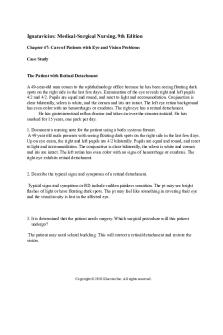TS Ch 13 Case Study PDF

| Title | TS Ch 13 Case Study |
|---|---|
| Course | Foundations of Nursing Practice |
| Institution | HCI College |
| Pages | 2 |
| File Size | 45.3 KB |
| File Type | |
| Total Downloads | 94 |
| Total Views | 138 |
Summary
Case Study...
Description
Case Study, Chapter 13, Fluid and Electrolytes: Balance and Disturbance 1. Mrs. Dean is a 75-year-old woman admitted to the hospital for a small bowel obstruction. Her medical history includes hypertension. Mrs. Dean is NPO. She has a nasogastric (NG) tube to low continuous suction. She has an IV of 0.9% NS at 83 mL/hr. Current medications include furosemide, 20 mg daily and hydromorphone, 0.2 mg every 4 hours, as needed for pain. The morning electrolytes reveal serum potassium of 3.2 mEq/L. (Learning Objective 4)
a. What are possible causes of a low potassium level?
The standard potassium range is 3.5 to 5.0 mmol/l. The potassium level of Mrs. Deans was 3.2 mEq/L, suggesting hypokalemia. Furosemide is a diuretic that, due to excessive urination, may induce hypokalemia. Hypokalemia may also be caused by NG tube suctioning.
b. What action should the nurse take in relation to the serum potassium level?
Contact the doctor to inform them of a fall in potassium level, include intravenous potassium if possible or as recommended for potassium substitution, apply loop diutretics, address the cause of hypokalemia, control electrolyte levels, facilitate a diet that improves potassium intake.
c. What clinical manifestations might the nurse assess in Mrs. Dean?
Medical symptoms of hypokalemia such as slow threaded heartbeat, diminished BP, orthostatic hypotension, altered mental state, agitation, confusion, lethargy, depressive ST, pronounced U waves, excessive PR, dysrhythmias, tachycardia, constipation, fatigue should be controlled by the nurse.
2. Conrad Jackson is a 28-year-old man who presents to the emergency department with severe fatigue and dehydration secondary to a 4-day history of vomiting. During the interview, he describes attending a family reunion and states that perhaps he “ate something bad.” Upon admission his vital signs are a temperature of 102.7°F, heart rate of 116 bpm, respiratory rate of 18 breaths/min, and blood pressure of 86/54 mm Hg. The nurse also notes the patient has dry mucous membranes and tenting of skin. The physician
orders an IV to be started with 0.45% normal saline, and orders a serum electrolyte and an arterial blood gas. (Learning Objective 7) The following results are returned from the laboratory: Sodium (Na+) Potassium (K+) Chloride (Cl¯) BUN Creatinine Glucose pH PaCO2 HCO3¯ PaO2 O2 Sat
150 5.5 110 42 0.8 86 7.32 35 20 90 98%
a. What is your interpretation of this arterial blood gas sample?
Metabolic acidosis
b. Explain the high potassium in this patient.
Vomiting and dehydration for four days after eating something unpleasant at a reunion. The patient may have other kidneyrelated underlying disorders. A diet rich in potassium could also be the cause.
c. Calculate the patient’s anion gap:
25.5
d. What is the interpretation of this anion gap?
25.5 is considered a high anion gap...
Similar Free PDFs

TS Ch 13 Case Study
- 2 Pages

Ch 13 - Ch 13
- 2 Pages

Case study ch 2
- 3 Pages

Ch 6 Bone case study
- 2 Pages

Ch 13 lecture notes - ch 13
- 2 Pages

Culture Anthro Ch. 10-13 Study Guide
- 22 Pages

CH 13 - Lecture notes 13
- 15 Pages

Chapter 13 - ch 13 notes
- 9 Pages
Popular Institutions
- Tinajero National High School - Annex
- Politeknik Caltex Riau
- Yokohama City University
- SGT University
- University of Al-Qadisiyah
- Divine Word College of Vigan
- Techniek College Rotterdam
- Universidade de Santiago
- Universiti Teknologi MARA Cawangan Johor Kampus Pasir Gudang
- Poltekkes Kemenkes Yogyakarta
- Baguio City National High School
- Colegio san marcos
- preparatoria uno
- Centro de Bachillerato Tecnológico Industrial y de Servicios No. 107
- Dalian Maritime University
- Quang Trung Secondary School
- Colegio Tecnológico en Informática
- Corporación Regional de Educación Superior
- Grupo CEDVA
- Dar Al Uloom University
- Centro de Estudios Preuniversitarios de la Universidad Nacional de Ingeniería
- 上智大学
- Aakash International School, Nuna Majara
- San Felipe Neri Catholic School
- Kang Chiao International School - New Taipei City
- Misamis Occidental National High School
- Institución Educativa Escuela Normal Juan Ladrilleros
- Kolehiyo ng Pantukan
- Batanes State College
- Instituto Continental
- Sekolah Menengah Kejuruan Kesehatan Kaltara (Tarakan)
- Colegio de La Inmaculada Concepcion - Cebu


![Ch. 13 Moral Development [study guide]](https://pdfedu.com/img/crop/172x258/ov3d790n83km.jpg)




